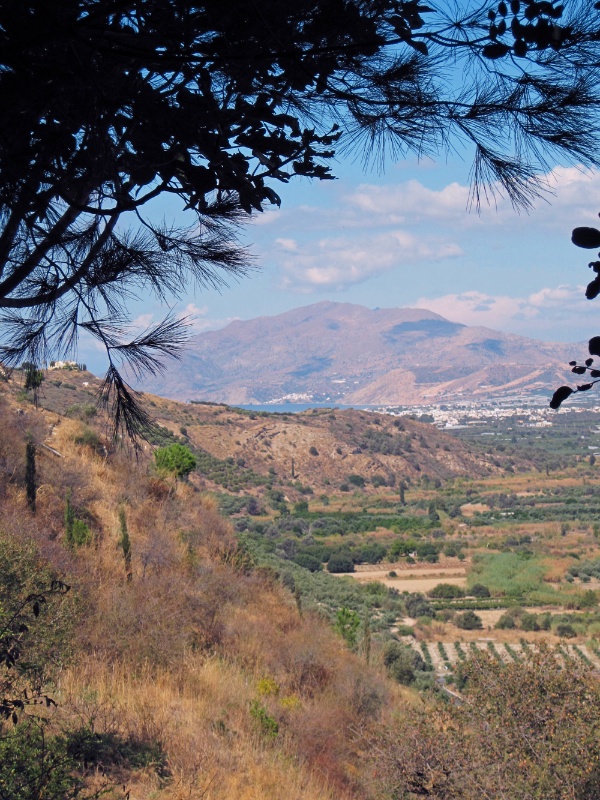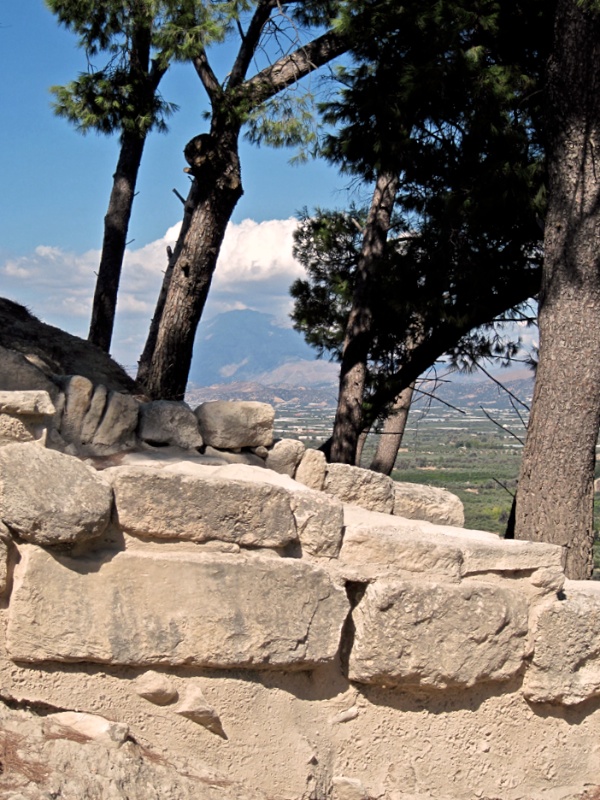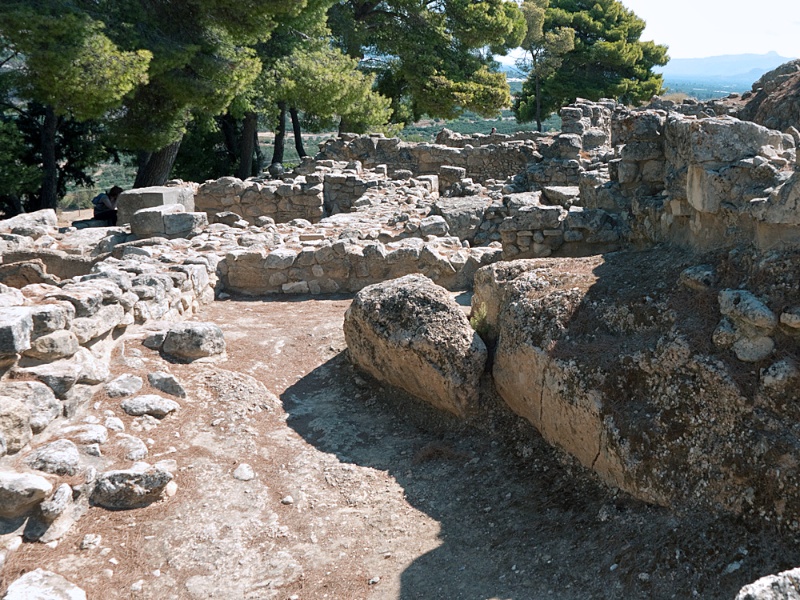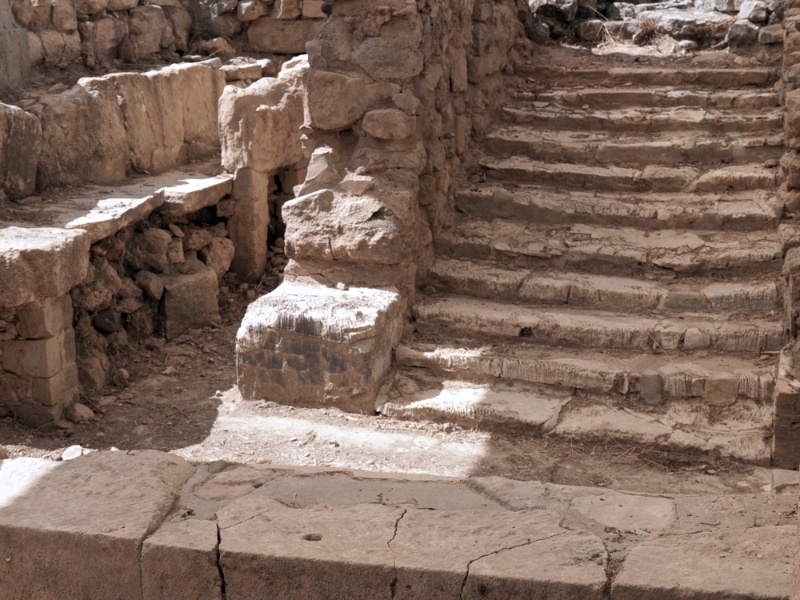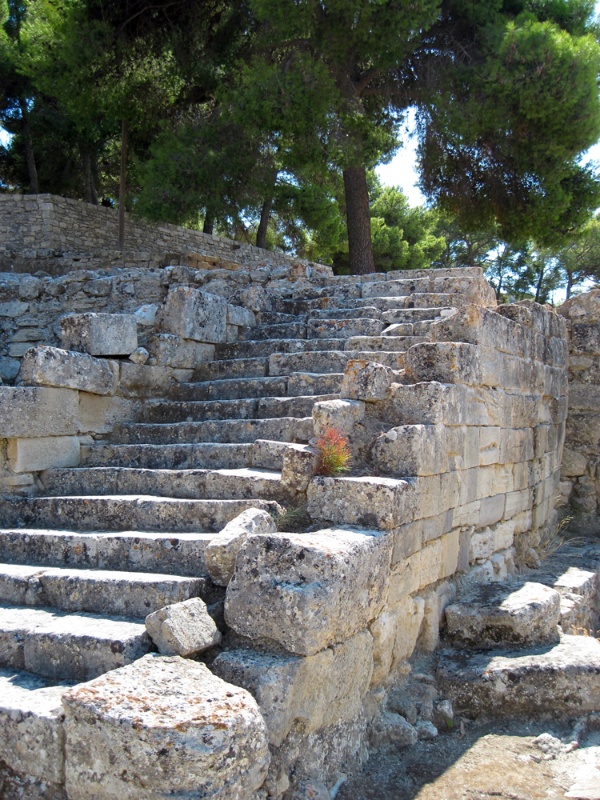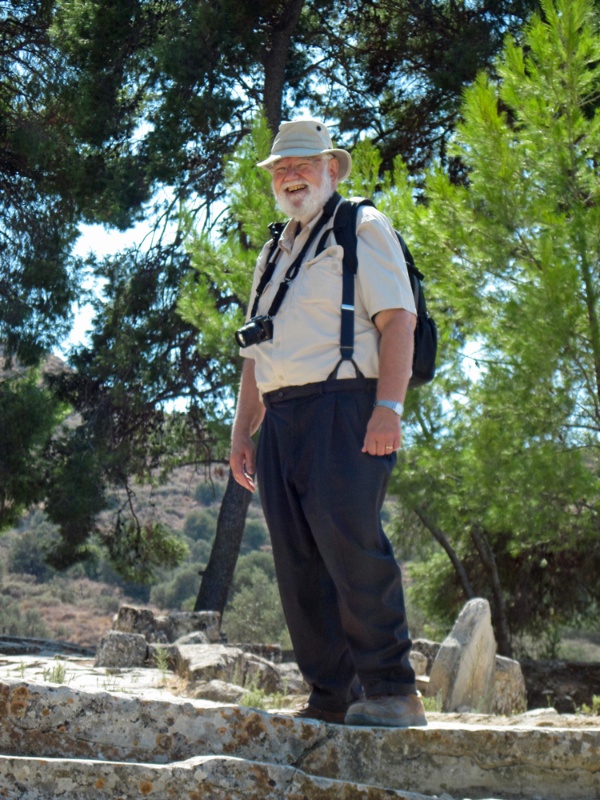-
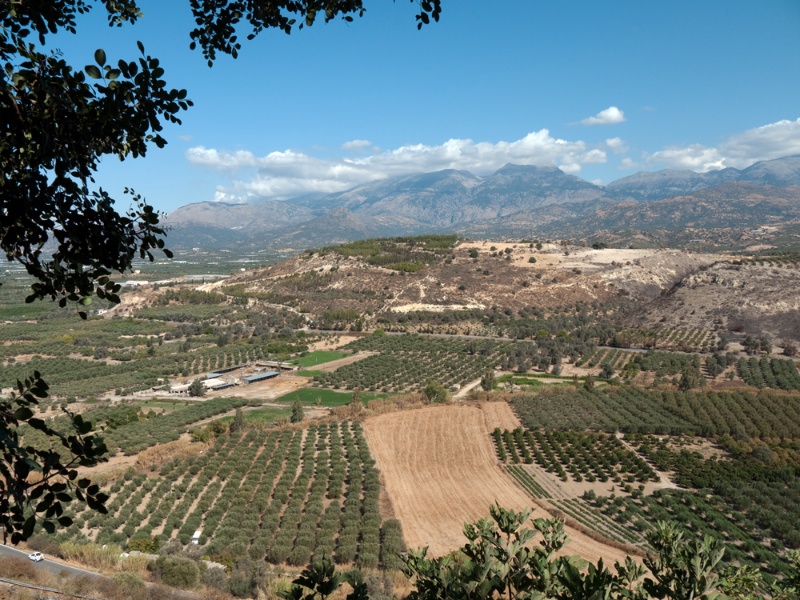 The Messara Plain from Phaistós #1One thing about Phaistós that you don't have to be an archaeologist to appreciate is the view. The Messará plain has always been Crete's richest agricultural area. It's shaped like a long, narrow triangle sheltered both north and south by mountains. The western end (the broadest part of the triangle) opens to the shore of the Libyan Sea at a point where the coastline has just taken a 90˚ turn and is running north-to-south.
The Messara Plain from Phaistós #1One thing about Phaistós that you don't have to be an archaeologist to appreciate is the view. The Messará plain has always been Crete's richest agricultural area. It's shaped like a long, narrow triangle sheltered both north and south by mountains. The western end (the broadest part of the triangle) opens to the shore of the Libyan Sea at a point where the coastline has just taken a 90˚ turn and is running north-to-south.
Perhaps the rulers took some pleasure in the sight of the farmers below raising grain and pressing oil, some of which was destined to end up in the palace's storerooms.To leave this gallery...
-
 Phaistos Palace: West CourtPart of this paved area is overlooked by broad stone steps that back up against a wall to form bleacher seats, so it's no wonder that the archaeologists declared it a "theatral area." Some kind of performances, ritual or otherwise, must have taken place there occasionally.
Phaistos Palace: West CourtPart of this paved area is overlooked by broad stone steps that back up against a wall to form bleacher seats, so it's no wonder that the archaeologists declared it a "theatral area." Some kind of performances, ritual or otherwise, must have taken place there occasionally.
As at Górtys, we saw relatively few other visitors. It's a big site, so we never got in each others' way.To leave this gallery...
-
 Grand StairwayThese twelve broad steps were carefully engineered, according to the Rough Guide: "Some of the steps are actually carved from the solid rock of the hill, and each is slightly convex in order to improve the visual impact." The stairway, which leads down into the west court, might have figured in the performances there, or perhaps its main purpose was to impress dignitaries arriving via the west gate.
Grand StairwayThese twelve broad steps were carefully engineered, according to the Rough Guide: "Some of the steps are actually carved from the solid rock of the hill, and each is slightly convex in order to improve the visual impact." The stairway, which leads down into the west court, might have figured in the performances there, or perhaps its main purpose was to impress dignitaries arriving via the west gate.To leave this gallery...
-
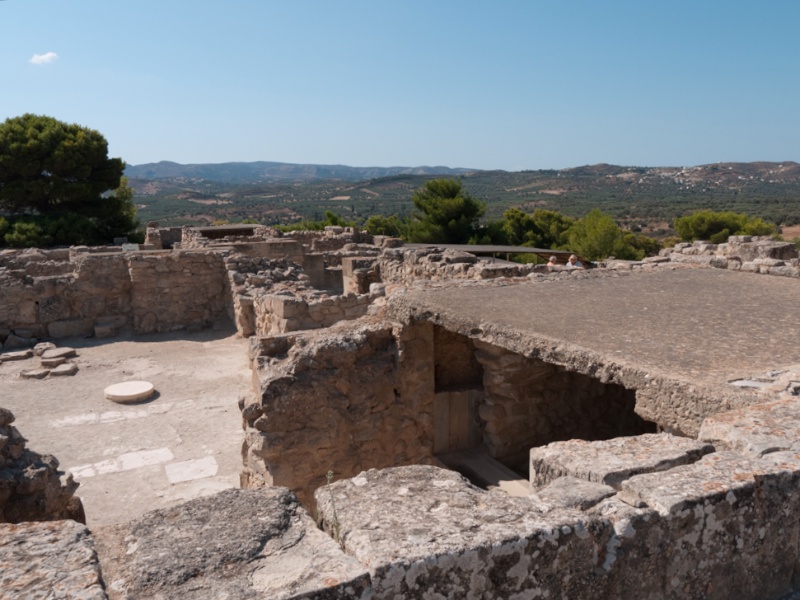 StoreroomsThough I'm not certain, I think the rooms in this part of the site were used to store oil and grain in massive píthoi—until an earthquake knocked over the oil lamps that constantly burned there. When lamps fell into the oil spilled from píthoi broken in the quake, a major fire started—a fate that befell all the Minoan palaces around 1450 BCE. Historians used to assume that the fires were started by conquering Mycenaeans, but there's no good evidence for a military invasion at that time, though Myceneans had already begun to settle on the island. The Minoans, their society in decline even before the disaster, never recovered, and, some time after 1450, Crete—peacefully, it's now believed—became part of the Mycenaean empire.
StoreroomsThough I'm not certain, I think the rooms in this part of the site were used to store oil and grain in massive píthoi—until an earthquake knocked over the oil lamps that constantly burned there. When lamps fell into the oil spilled from píthoi broken in the quake, a major fire started—a fate that befell all the Minoan palaces around 1450 BCE. Historians used to assume that the fires were started by conquering Mycenaeans, but there's no good evidence for a military invasion at that time, though Myceneans had already begun to settle on the island. The Minoans, their society in decline even before the disaster, never recovered, and, some time after 1450, Crete—peacefully, it's now believed—became part of the Mycenaean empire.To leave this gallery...
-
 Bench and basin (?)I don't quite know where this picture was taken. The reconstructed structure on the floor looks like either a basin or perhaps a mortar for grain grinding, but on the other hand, the marble bench suggests that this is a part of the palace where Gracious Living was carried on.
Bench and basin (?)I don't quite know where this picture was taken. The reconstructed structure on the floor looks like either a basin or perhaps a mortar for grain grinding, but on the other hand, the marble bench suggests that this is a part of the palace where Gracious Living was carried on.To leave this gallery...
-
 The queen's megaronArchaeologists named this room—influenced, perhaps by Evans' interpretations at Knossós, as all archaeologists since his time have been. Sir Arthur's identifications may have been speculative, but the huge, jumbled palace sites are so confusing that any sort of model that makes sense of them is bound to be influential.
The queen's megaronArchaeologists named this room—influenced, perhaps by Evans' interpretations at Knossós, as all archaeologists since his time have been. Sir Arthur's identifications may have been speculative, but the huge, jumbled palace sites are so confusing that any sort of model that makes sense of them is bound to be influential.
Megaron translates conveniently as ‘great room,’ a term many American suburbanites have become familiar with in recent years. This picture shows about half of it; the other half also contains a pair of pillars, These no doubt helped support the additional story or stories overhead that couldn't be reconstructed.To leave this gallery...
-
 Reconstruction and attritionPhaistós was excavated by an Italian team starting at the turn of the 20th century; more work was done in the 1950s under the auspices of the Italian School of Archaeology. Reconstruction was done more cautiously here than it was at Knossós—for instance, no concrete was poured where it would prevent possible future investigation. In this room, you can see that the terra cotta squares used for flooring have suffered during the decades (whether eleven or six) since they were put down. Hot Cretan summers seem to have distorted some, while others are broken in pieces (possibly from being stepped on after they assumed the concave shape we can see in the unbroken ones).
Reconstruction and attritionPhaistós was excavated by an Italian team starting at the turn of the 20th century; more work was done in the 1950s under the auspices of the Italian School of Archaeology. Reconstruction was done more cautiously here than it was at Knossós—for instance, no concrete was poured where it would prevent possible future investigation. In this room, you can see that the terra cotta squares used for flooring have suffered during the decades (whether eleven or six) since they were put down. Hot Cretan summers seem to have distorted some, while others are broken in pieces (possibly from being stepped on after they assumed the concave shape we can see in the unbroken ones).To leave this gallery...
-
 First palace?Though I'm not sure, the tumbledown stones in this picture may belong to the first palace, destroyed (like other palaces) in an earthquake about 1700 BCE. The Minoans were at that time still a wealthy and vigorous people, and rebuilt their palaces larger and richer than before. Phaistós was rebuilt on top of the ruins, some of which (probably fully concealed when the second palace was built) were uncovered in the 1950s.
First palace?Though I'm not sure, the tumbledown stones in this picture may belong to the first palace, destroyed (like other palaces) in an earthquake about 1700 BCE. The Minoans were at that time still a wealthy and vigorous people, and rebuilt their palaces larger and richer than before. Phaistós was rebuilt on top of the ruins, some of which (probably fully concealed when the second palace was built) were uncovered in the 1950s.To leave this gallery...
-
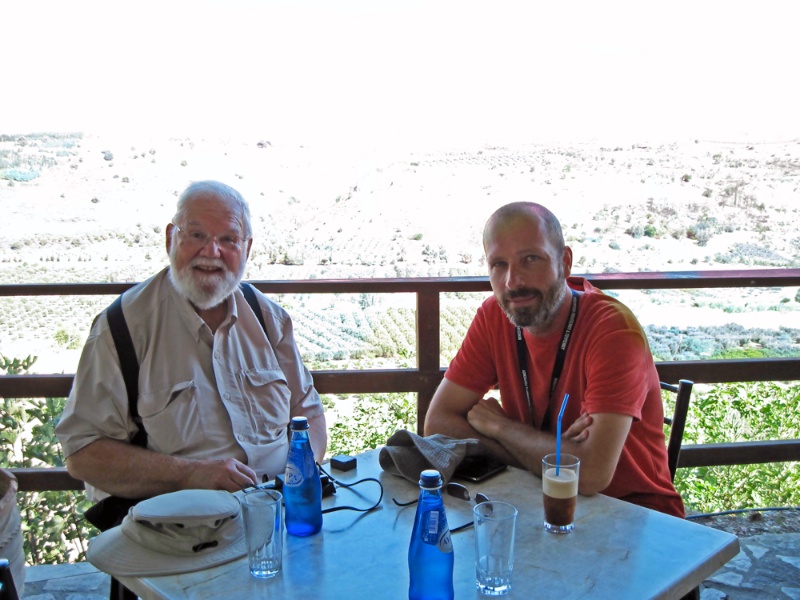 Charlie and GeorgeAfter touring the site we enjoyed a chance to sit down and drink something cool—George's was coffee, but the exotic blue bottles in the picture (mine and Dorothea's) held water.
Charlie and GeorgeAfter touring the site we enjoyed a chance to sit down and drink something cool—George's was coffee, but the exotic blue bottles in the picture (mine and Dorothea's) held water.
Despite appearances, there had been no sudden snowfall outside; that's just what happens to a bright background when you have to overexpose it so as not to underexpose what's in the foreground.To leave this gallery...
-
 At Agía Triáda #1Our last stop on the day's excursion was a villa rather than a palace. It's very near Phaistós, a little closer to the sea, but not as much elevated. It's a little harder to see the water (the same part of it we saw from Phaistós), as this picture shows.
At Agía Triáda #1Our last stop on the day's excursion was a villa rather than a palace. It's very near Phaistós, a little closer to the sea, but not as much elevated. It's a little harder to see the water (the same part of it we saw from Phaistós), as this picture shows.
Many fine works of art were found here, and are housed in the museum at Iráklio, but the remains of the buildings, from several eras, are "jumbled, […] confused, and confusing," in the Rough Guide's words. This didn't matter a lot to us—the pleasant day, the dappled shade on tumbled stones, and the almost complete absence of other visitors made our visit a lovely experience. We saw some of the same kinds of objects we'd seen at the other sites, but I chose most of the pictures for esthetic rather than informational reasons. Ironically, the ruin that made the deepest impression on us was a tiny Christian chapel from the Byzantine era, approximately 2,000 years younger than the Minoan villa.To leave this gallery...
-
 At Agía Triáda #2From the Rough Guide: "…the most commonly accepted explanation is that it was some kind of royal villa, but it may equally have been the home of an important prince or a wealthy, ship-owning merchant, a building of special ceremonial significance, or even (as more recent theories have it, based on the quantity of records and storage found here) simply an administrative centre."
At Agía Triáda #2From the Rough Guide: "…the most commonly accepted explanation is that it was some kind of royal villa, but it may equally have been the home of an important prince or a wealthy, ship-owning merchant, a building of special ceremonial significance, or even (as more recent theories have it, based on the quantity of records and storage found here) simply an administrative centre."To leave this gallery...
-
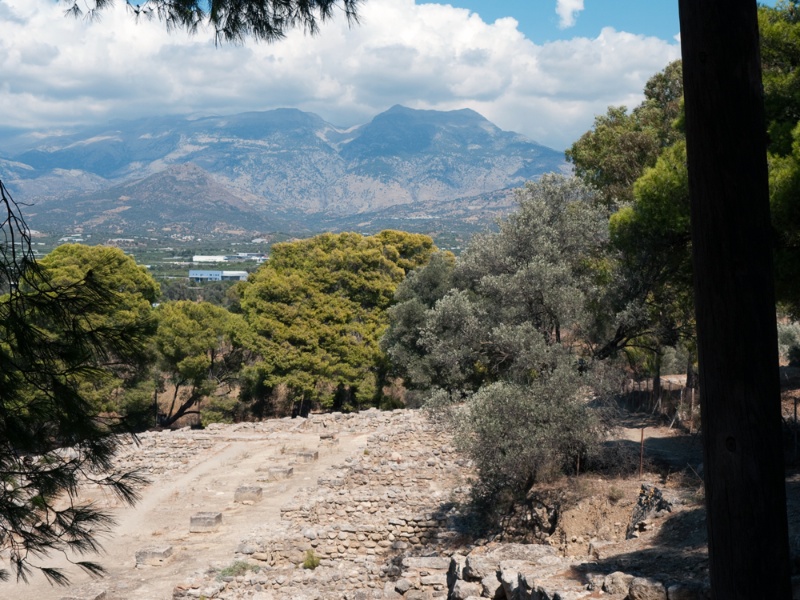 Shopping centerThe ruins at the northern end of the site, George told us , belonged to a town that flourished here in the period when the Minoan culture was in decline and the Mycenaeans were taking over. The area in this picture was the market, which had a row of stone-built, arcaded shops: you can see the parallel walls of the narrow shops and the bases of the pillars that supported the roof of the arcade. Whether this architecture and construction originated with the Minoans or the Myceneans is unknown.
Shopping centerThe ruins at the northern end of the site, George told us , belonged to a town that flourished here in the period when the Minoan culture was in decline and the Mycenaeans were taking over. The area in this picture was the market, which had a row of stone-built, arcaded shops: you can see the parallel walls of the narrow shops and the bases of the pillars that supported the roof of the arcade. Whether this architecture and construction originated with the Minoans or the Myceneans is unknown.To leave this gallery...
-
 Ágios Geórgios church #1This tiny church has been here only since the 14th century, when there must have been a nearby village large enough to support a priest. It’s dedicated to Greece’s patron, St. George, rather than the Holy Trinity, as the name that has been given to the villa might make you think. (That's what Agía Triáda means in Greek.) Needless to say, neither the Minoans nor the Mycenaeans used that name, which the Rough Guide says was adopted by the Italian archaeologists (the same ones who excavated Phaistós) “from a nearby chapel.” I can't find any trace of it on either the map or the Internet, however.
Ágios Geórgios church #1This tiny church has been here only since the 14th century, when there must have been a nearby village large enough to support a priest. It’s dedicated to Greece’s patron, St. George, rather than the Holy Trinity, as the name that has been given to the villa might make you think. (That's what Agía Triáda means in Greek.) Needless to say, neither the Minoans nor the Mycenaeans used that name, which the Rough Guide says was adopted by the Italian archaeologists (the same ones who excavated Phaistós) “from a nearby chapel.” I can't find any trace of it on either the map or the Internet, however.To leave this gallery...
-
 Ágios Geórgios church #3Here’s the interior of the church. The original frescos have suffered much with time, though parts of them are still visible. As at Górtys, the little church is honored as a holy place with the addition of modern icons—a large one of the patron saint slaying the dragon and a small one of the Virgin and Child.
Ágios Geórgios church #3Here’s the interior of the church. The original frescos have suffered much with time, though parts of them are still visible. As at Górtys, the little church is honored as a holy place with the addition of modern icons—a large one of the patron saint slaying the dragon and a small one of the Virgin and Child.To leave this gallery...

